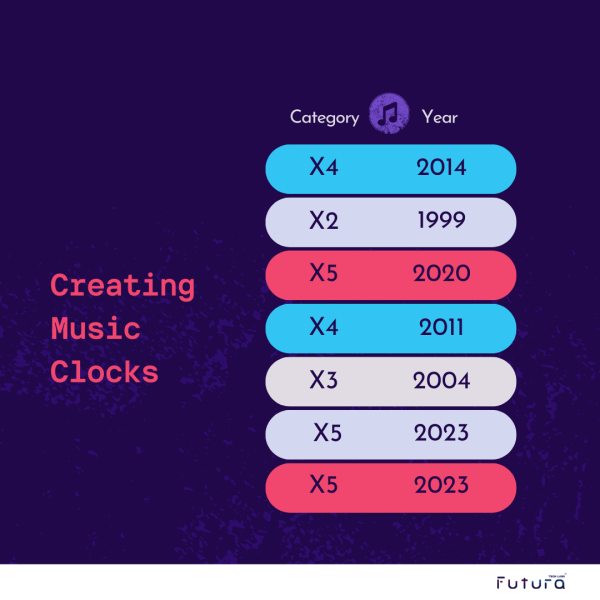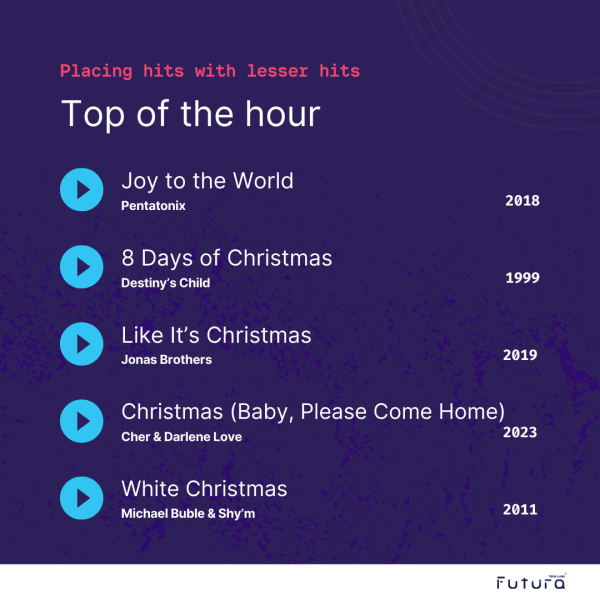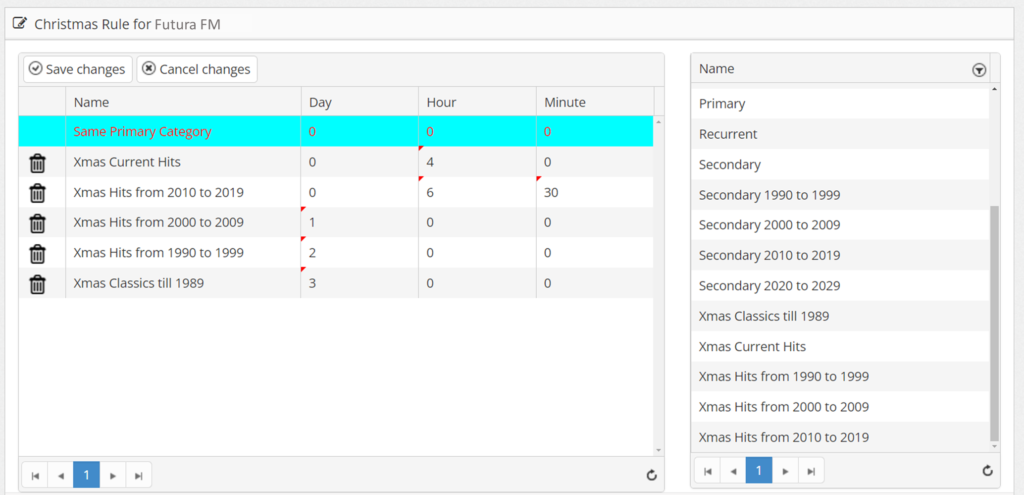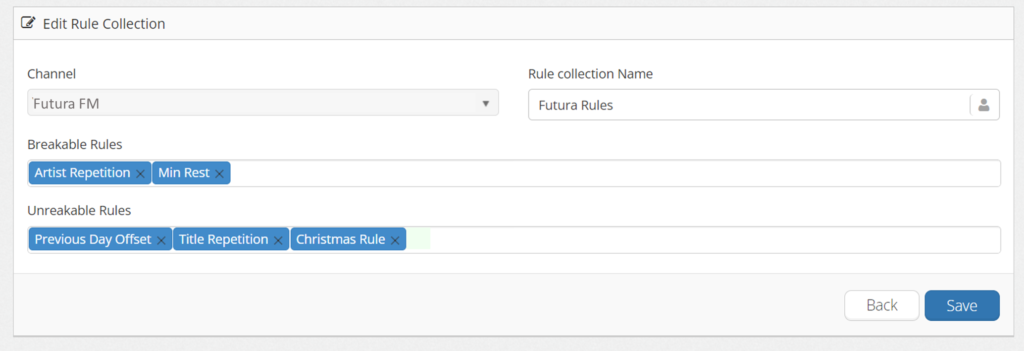Table of Contents

The holiday season is upon us, and as radio programmers, there’s no better gift you can give your CHR/Top 40 audience than the perfect radio Christmas playlist. Creating the ultimate radio playlist is an art and science with a magical blend of nostalgia, joy, and a sprinkle of contemporary vibes.
Let’s unwrap the secrets to curating the perfect Christmas soundtrack that will make your heart sing and your holiday gatherings merrier.
BONUS: Check out the ultimate radio Christmas playlist curated for you at the end of this article!
1. Understand your audience
Finding out what your listeners like to listen to is a crucial element in radio programming. While CHR / Top 40 stations play the current hits all year long, Christmas is the one hall pass you get that lets you relax your rules and format.
Do you know why?
Because it is a time for familiarity, comfort, warmth, family, love, and friends. Everyone wants to listen to Christmas songs and carols that we all know and can sing along to.
What differs is the sound: is your audience fans of traditional classics, modern hits, or a diverse mix?
On a Retro/Classics station, you wouldn’t play Arianna Grande’s version of ‘Last Christmas’ over Wham’s version, but both versions will work on a CHR / Top 40 station.
Last Christmas – Arianne Grande (2013)
Last Christmas – Wham! (1984)
2. Blend tradition with modern
That brings us to no. 2 on how blending the familiar with newer Christmas songs helps CHR / Top 40 stations.
From Bing Crosby’s velvety ‘White Christmas’ to Nat King Cole’s soulful ‘The Christmas Song,’ these tunes form the cornerstone of any festive collection.
While traditional Christmas carols evoke a sense of nostalgia, incorporating modern interpretations keeps your playlist fresh and engaging. Artists like Michael Bublé, Pentatonix, and Sia offer fresh takes on Christmas songs, infusing your playlist with a contemporary charm that appeals to a diverse audience.
You can play these two songs back-to-back:
I’ll Be Home For Christmas – Camila Cabello (2022)
The Christmas Song – Christina Aguilera (2000)
And then follow it up with a song from the 2010s to keep it more fresh sounding. Follow-up songs are the true definers in your playlist that can make or break your audience.
Remember that balance is key – create a harmonious blend of old and new that appeals to a broad spectrum of tastes.
3. Create rollercoaster music clocks
Build a Christmas music clock that helps you navigate different eras and genres. As a storyteller, you must take your audience on a thrilling rollercoaster ride while navigating the intricacies of surprises and predictability.
How will you mash the current hits with classics? Categorise your Christmas songs based on a genre or decade.
Using mStudio radio automation software, I can easily create and change the order of the categories. mCollector provides a web-based music management and scheduling application that allows users to manage the song library and create and schedule playlists.
I prefer to create categories based on decades due to the low volume of Christmas songs and their usage.

Since I am creating a clock for a CHR / Top 40 station, I will utilise 40% traditional and 60% modern mix of Christmas songs.

4. Place songs strategically
When it comes to radio programming, we must look into three areas:
a) Placing hits amongst non-hits: Add hit songs at strategic points, such as at the Top of the hour (TOH) or just after the commercial belt, to reward and capture the listeners’ attention.
Spread lesser-known songs amongst these hits to maintain intrigue. This way, your audience will listen to a newer Christmas song with the promise that the next song will be a hit and a song they know.

b) Creating a good flow and transition: Not only should you place hits amongst newer, less-known ones, but they also need to flow well.
Song flow means having a seamless transition from one song to another in a playlist. It involves selecting and organising songs in a way that maintains a smooth and enjoyable listening experience for the audience.
To create a cohesive flow, you must consider genre, tempo, mood and energy, ensuring that one song transitions smoothly into the next without abrupt changes.
- Genre – There is a Christmas tune for every musical palate. So, adding a diverse list of genres will provide something for everyone. Play Etta James’ jazz version of ‘Merry Christmas Baby’ to Queen’s classic rock ‘Thank God It’s Christmas’. But don’t play the same genre more than twice. Switch it up with an R&B Christmas song after 2 pop songs.
As homework, aim to change the genre within 1 song. It’s not often easy, but practice and exposure to lots of songs will help you get there.
- Tempo – Ensure that a song’s Tempo Out of 2 (medium slow outro) transitions with the next song’s Tempo In either 1 (slow intro), 2 (medium slow) or 3 (medium). Don’t follow a fast song with a slow song unless the radio DJ breaks it with a talk segment.
- Mood – Follow a melancholy song with a neutral or medium happy song. Don’t play 2 sad or melancholy songs back-to-back unless it’s a special theme, show or daypart.
- Energy – Inject energy into your playlist with upbeat and lively tracks that capture the spirit of celebration. Mariah Carey’s ‘All I Want for Christmas Is You’ is a modern classic that never fails to get everyone in the holiday groove. But continuously playing high-energy songs may bore your listeners.
Alternate between upbeat and mellow tracks to create a dynamic listening experience. There are exceptions where one type of energy works best, such as a special Saturday night radio show focusing on Deep House music
c) Understanding radio dayparts:
Every day has its mood. A rainy day calls for more chill and easy-listening music, while a Friday calls for more upbeat, high-energy songs.
At the same time, every part of the day also has its mood. You will consider playing more upbeat songs in the morning and limit slow songs because you want your listeners to start their day on an energetic and positive note.
But at night, after around 6.30 pm, it’s alright to play more downtempo, less energy, and neutral and sad songs. This daypart helps your listeners relax and turn off their busy minds.
Identifying your dayparts and understanding which songs work best in what time belt helps you create better categorisations, formats, music clocks and flow.
5. Create healthy rotations
Just because Christmas comes once a year doesn’t mean you should play the same song today, tomorrow and the day after.
Seasonal songs generally fall into a small pool of songs, so you may not have many options to choose from. And playing different versions of “Have Yourself A Merry Christmas” every hour will not cut it either. You will only bore your audience and send them to another radio station.
So, create healthy and realistic song rotations with clear breakable and unbreakable rules. Find the right airplay balance; too much or too less can hurt your radio station.
For example, you can define a specific rule based on the category, title or artist attributes and then define a repetition or rest rule.
In the below image, I have defined the repetition rule for any song in that category using mCollector. Let’s say that ‘Merry Christmas’ by Ed Sheeran and Elton John is in X5 category that contains Xmas Current Hits. If this song played at noon, it can play again after 4 pm. That’s what we are defining here.

Once I do this, I can add the Christmas rule to a collection and indicate if it goes under the breakable or unbreakable rule group.

BONUS: The ultimate radio Christmas playlist
Your reward is here! I have added the perfect Christmas playlist to showcase everything I mentioned in this article. Click the playlist icon below to check the full Christmas playlist.
Creating the perfect radio Christmas playlist is a work in progress. By understanding your audience, embracing diversity, and maintaining a dynamic playlist, you can craft a holiday musical experience that resonates with your listeners and spreads festive joy.
Keep it dynamic by continuously updating and refreshing the selection. Discover new releases, explore different eras, and adapt your playlist to reflect the evolving sounds of the season.
Let the holiday magic unfold over the airwaves.

